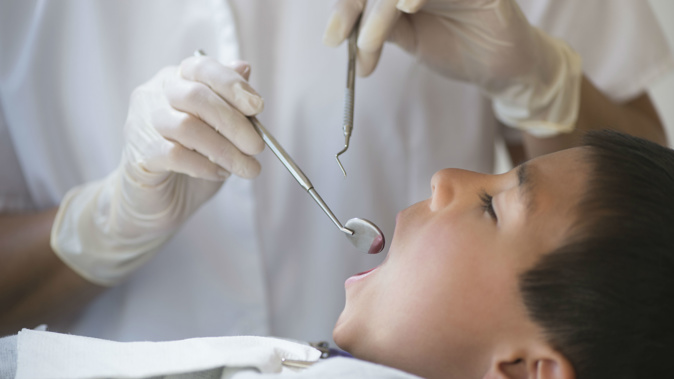
- Over half of children on the dental surgery waitlist have waited over four months.
- Health New Zealand data shows 2942 children have been waiting more than 120 days.
- Workforce shortages and Covid-19 impacts are contributing to the growing waitlist and delays.
More than half of the children on the waitlist for dental surgery have been waiting more than four months.
Data from Health New Zealand shows as of March, there were 5,564 young people aged 14 and under on the waitlist, with 2,942 waiting more than 120 days.
The overall waitlist has grown by about 1500 children in two years, up from around 4000 in March 2023.
Hospital teams carry out dental services that can’t be completed in the community for a variety of reasons - including special medical needs, behavioural difficulties or because the child needs multiple procedures at the same time - such as extractions, and wouldn’t be able to tolerate this under local anaesthetic.
Dental Association Director of Dental Policy Robin Whyman says the number waiting longer than four months is “concerningly large”.
“Most of these children will have been referred with quite a high level of dental disease.”
He says sometimes they’ve got more complex dental conditions that need to be addressed - such as developmental problems in their teeth that need to be extracted.
“Most of the children will have had some level of infection, and pain, and so that continues to be managed almost on a day by day with things like pain relief and antibiotics until they can get access to care, which is not what we want to have happening.”
He says waiting more than four months can not only feel like a long time for young children - but also has some level of clinical risk.
“Children can go on to develop quite severe infections from the infected teeth, so concerning for the children, concerning for their parents and also concerning for the clinicians.”
He says we need to get the wait list down “as quickly as we can”.
“But realistically this is going to take months, if not a year or so probably, to bring under a level of control.”
“What really needs to happen is a focus on the early years and the issues that are driving the levels of dental decay we’ve got - that’s sugar in our diets and the levels of sugar consumption, but also the demand and the ability to deliver the community oral health services where many of these children can be seen earlier and disease prevented.”
Health New Zealand Chief Clinical Officer Dr Richard Sullivan has acknowledged a lack of access to community services for children and adolescents is driving the growth in demand for hospital level dental treatment.
“All dental services across the country were significantly impacted in 2020 and again in 2021 due the Covid-19 lockdowns. This resulted in delays in both community and hospital dental care across the country.”
He says another issue that has contributed to waiting list growth over the last few years, and continues to impact capacity, is domestic and global shortages in the oral health workforce.
Whyman says 2023 Health New Zealand data shows there are 825,000 children enrolled with a community oral health service, and around 36 percent of them are overdue for care.
He says the workforce is a big challenge here - with a significant number of vacancies.
Whyman says there needs to be a more coordinated approach with the tertiary education sector to addressing shortages, particularly for dentists and oral health therapists.
There has been some increase in oral health therapy training positions, but he says the number of dentists in training hasn’t changed at all.
“Without an increase in the supply of both workforces, we will continue to struggle to deliver the oral healthcare we need.”
Sullivan says there are a number of initiatives underway to improve access to dental care in the community.
They include making concerted efforts to address the backlog of children who are overdue to be seen at a community oral health service, including referring Year 7 and 8 children to funded private dental practices.
There was also funding 20 new mobile dental clinics in Budget 2022 - which are being delivered in two tranches, prioritising areas with the highest inequities. So far, six of the seven in the first tranche have been delivered.
Oral health therapists are being treated as a priority workforce - with a collaboration between AUT and Health NZ working to address the shortage by supporting Bachelor of Health Science (Oral Health) students to train closer to home.
Sullivan says improving dental wait times for children is part of a broader strategy to reduce elective surgical wait times.
He says a recent national boost to outsourcing will increase the number of procedures they are able to deliver, by utilising additional capacity in the private sector.
Sullivan says Health NZ also continues to contract mobile surgical dental services, particularly for tamariki in smaller urban and rural areas.
“Over the last two years, more than 2,500 children aged 0-14 years have received dental care through this service.”
He says regions have also set up their own programmes to help meet the Government’s health target - such as one in Canterbury, where half a million dollars is being spent on outsourcing 100 procedures under general anaesthetic and running extra first specialist appointment clinics for 300 children by the end of next month.
Whyman says the initiatives Health NZ has underway are the right ones.
“It comes down to an issue of supply and being able to deliver more care... more theatre lists and using resources such as private surgery and mobile surgical services is a good way of increasing capacity.”
“The challenge that will sit there, is that it needs the workforce associated with the group - and not just a dentist workforce, this needs anaesthetists, it needs theatre nursing teams, it needs anaesthetic technicians.”
He says they all need to be available, and many of them are needed to deliver other waitlist priorities as well.
Take your Radio, Podcasts and Music with you









